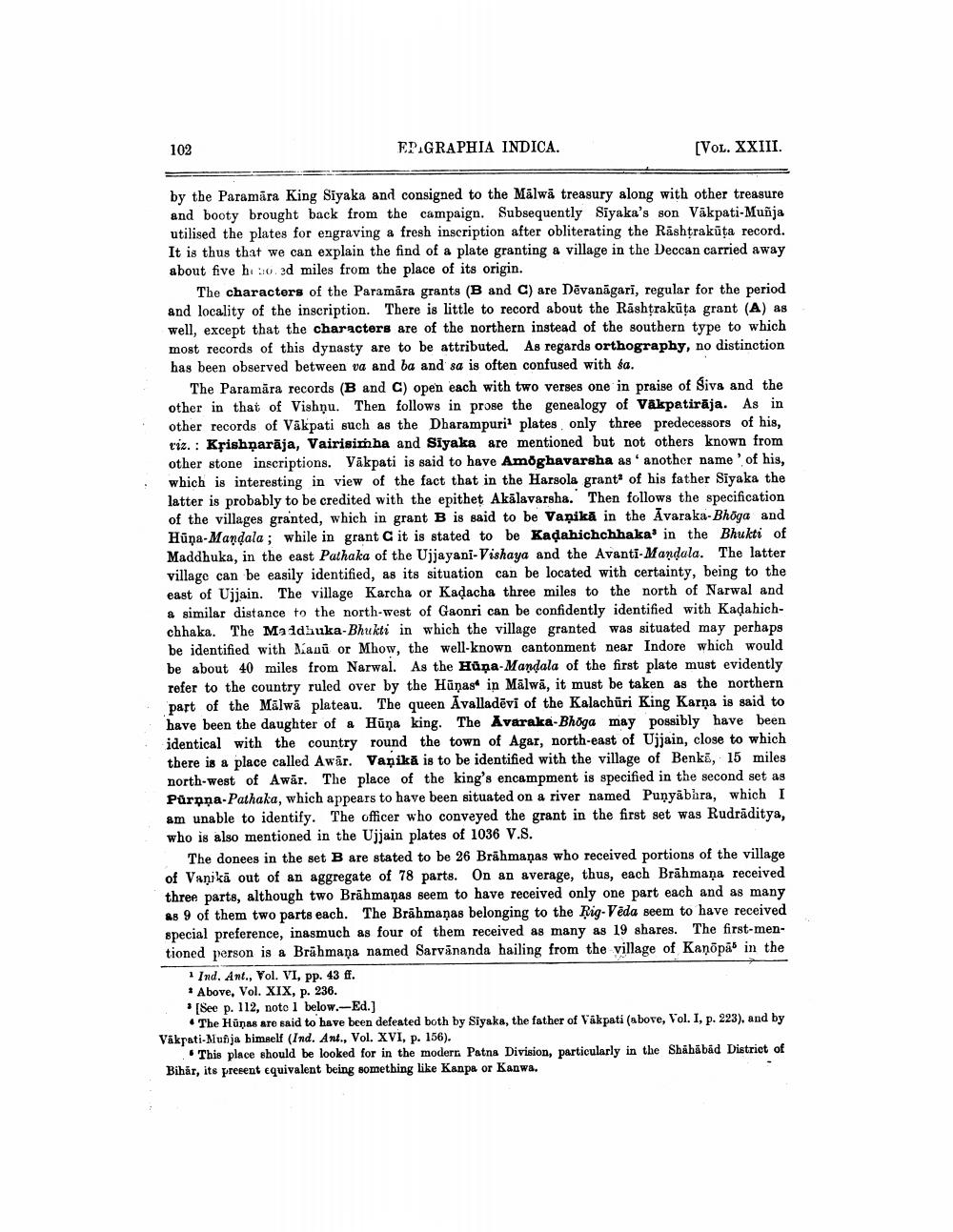________________
102
EP.GRAPHIA INDICA.
[VOL. XXIII.
by the Paramāra King Siyaka and consigned to the Mälwă treasury along with other treasure and booty brought back from the campaign. Subsequently Siyaka's son Vākpati-Muñja utilised the plates for engraving a fresh inscription after obliterating the Rashtrakūta record. It is thus that we can explain the find of a plate granting a village in the Deccan carried away about five h 30 3d miles from the place of its origin.
The characters of the Paramāra grants (B and C) are Dēvanāgari, regular for the period and locality of the inscription. There is little to record about the Rashtrakūta grant (A) as well, except that the characters are of the northern instead of the southern type to which most records of this dynasty are to be attributed. As regards orthography, no distinction has been observed between va and ba and sa is often confused with $a.
The Paramāra records (B and C) open each with two verses one in praise of Siva and the other in that of Vishņu. Then follows in prose the genealogy of Vakpatirāja. As in other records of Vākpati such as the Dharampuri plates only three predecessors of his, riz. : Krishộarāja, Vairisimha and Siyaka are mentioned but not others known from other stone inscriptions. Vākpati is said to have Amoghavarsha as another name of his, which is interesting in view of the fact that in the Harsola grant of his father Siyaka the latter is probably to be credited with the epithet Akālavarsha. Then follows the specification of the villages granted, which in grant B is said to be Vaņikā in the Avaraka-Bhöga and Hūņa-Mandala ; while in grant C it is stated to be kadahichchhaka' in the Bhukti of Maddhuka, in the east Pathaka of the Ujjayani-Vishaya and the Avanti-Mandala. The latter village can be easily identified, as its situation can be located with certainty, being to the east of Ujjain. The village Karcha or Kadacha three miles to the north of Narwal and a similar distance to the north-west of Gaonri can be confidently identified with Kadahichchhaka. The Madhuka-Bhukti in which the village granted was situated may perhaps be identified with lanû or Mhow, the well-known cantonment near Indore which would be about 40 miles from Narwal. As the Hüņa-Mandala of the first plate must evidently refer to the country ruled over by the Hūnast in Mälwā, it must be taken as the northern part of the Malwă plateau. The queen Avalladēvi of the Kalachūri King Karna is said to have been the daughter of a Hūņa king. The Avaraka-Bhoga may possibly have been identical with the country round the town of Agar, north-east of Ujjain, close to which there is a place called Awar. Vaņikā is to be identified with the village of Benkā, 15 miles north-west of Awar. The place of the king's encampment is specified in the second set as Purpņa-Pathaka, which appears to have been situated on a river named Punyabira, which I am unable to identify. The officer who conveyed the grant in the first set was Rudrāditya, who is also mentioned in the Ujjain plates of 1036 V.S.
The donees in the set B are stated to be 26 Brāhmaṇas who received portions of the village of Vanikā out of an aggregate of 78 parts. On an average, thus, each Brāhmaṇa received three parts, although two Brāhmaṇas seem to have received only one part each and as many as 9 of them two parts each. The Brāhmaṇas belonging to the Rig Veda seem to have received special preference, inasmuch as four of them received as many as 19 shares. The first-mentioned person is a Brāhmaṇa named Sarvānanda hailing from the village of Kaņāpās in the
* Ind. Ant., Vol. VI, pp. 43 ff. * Above, Vol. XIX, p. 236.
[See p. 112, note 1 below.-Ed.)
• The Hūnas are said to have been defeated both by Siyaka, the father of Vakpati (above, Vol. I, p. 223), and by Väkrati-Mufja himself (Ind. Ant., Vol. XVI, p. 156).
. This place should be looked for in the moderr Patna Division, particularly in the Shabābād District of Bihar, its present equivalent being something like Kanpa or Kanwa.




